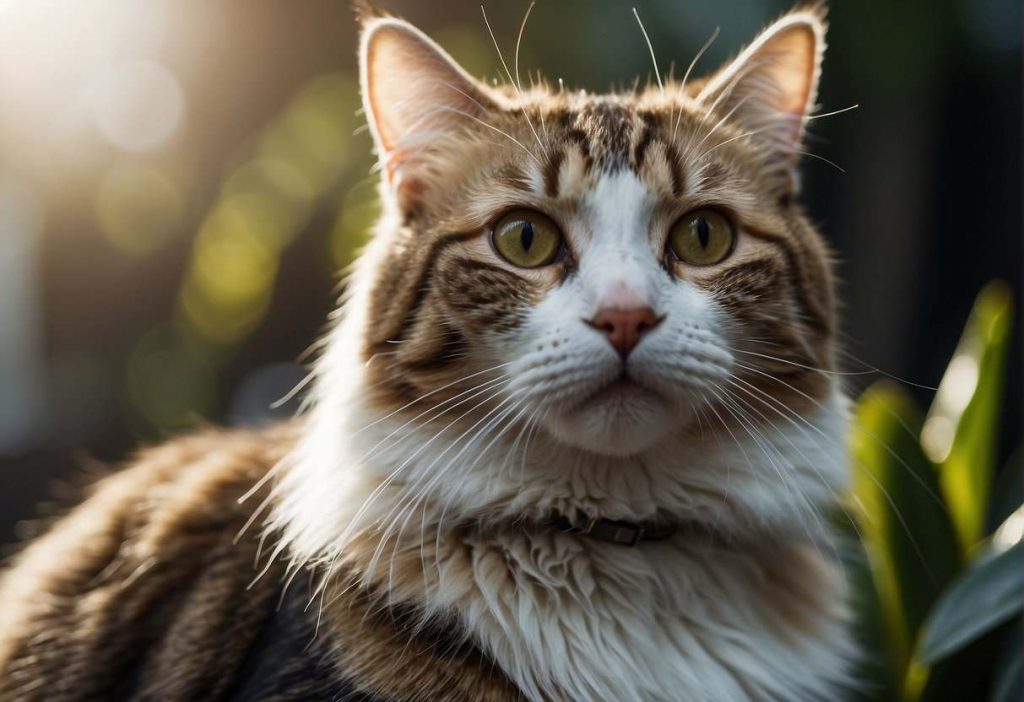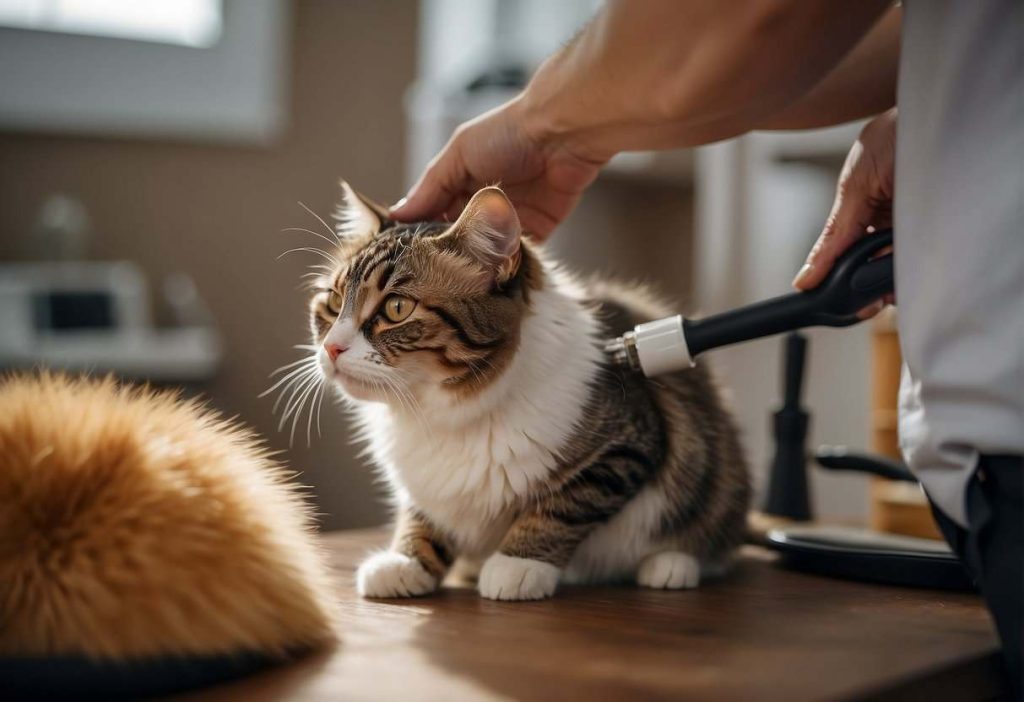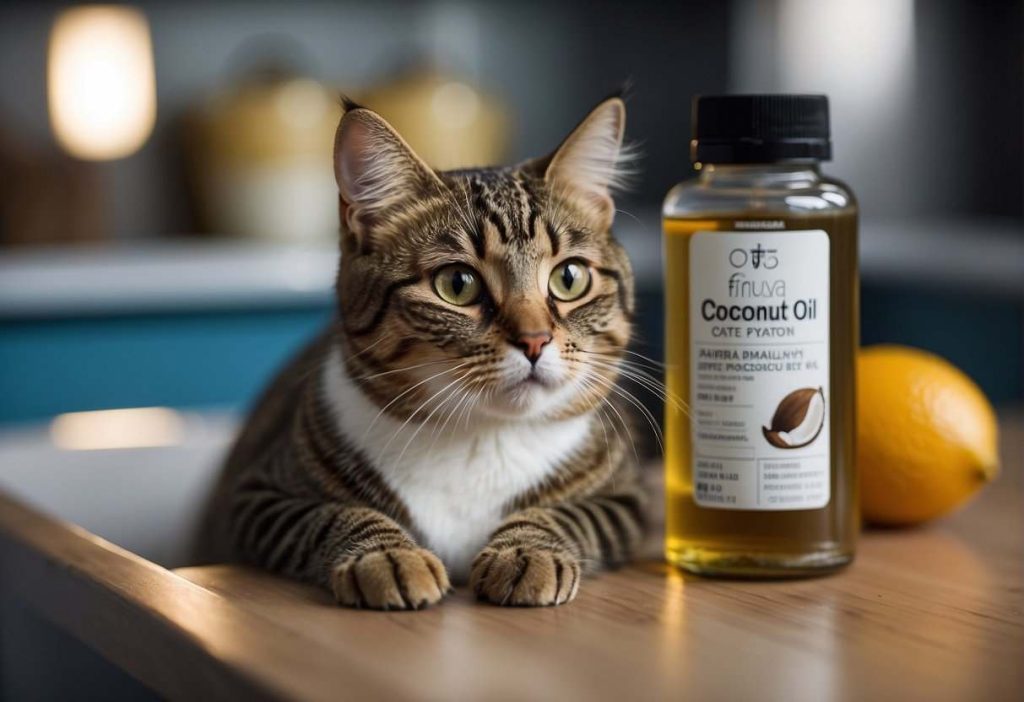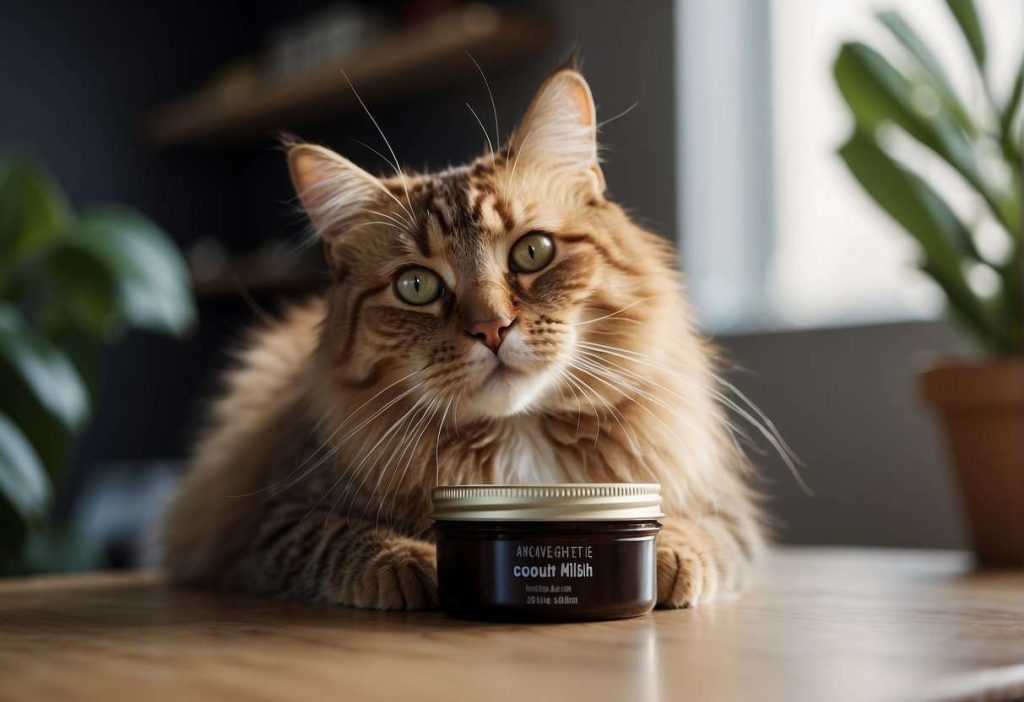What is the benefit of coconut oil for hairballs in cats?
Ever noticed your feline friend gagging and coughing up a hairball? It’s a fairly common experience for cat owners.
Hairballs occur as cats groom themselves and swallow hair, which can accumulate and form a ball in their digestive tract. If your kitty is frequently coughing up hairballs, it can be both concerning and messy. (1)
Thankfully, there are several methods to cure and prevent hairballs, including giving your pet cat a hairball laxative or incorporating a hairball formula cat food into their diet.

Now, you might be scratching your head, wondering if there’s a natural remedy to help your cat. Have you heard about the buzz around coconut oil?
That’s right, the same coconut oil that you might use in your cooking or skincare routine. It’s gaining traction in holistic pet care circles for its potential health benefits for our fluffy companions.
Could coconut oil be the answer to managing your cat’s hairball woes?
Not only can coconut oil help treat hairballs, but it also helps keep the cat’s skin and coat healthy, which can prevent hair from getting caught up in their tongue.
Coconut oil also encourages the developed hairball to pass through the cat’s digestive tract, thanks to its ability to increase metabolism.
It might just be worth a shot, but let’s ensure you’re not jumping into this without all the facts.
Key Takeaways
- Coconut oil is considered by some as a natural option to help cats with hairball issues.
- It is important to approach the use of coconut oil with an understanding of its potential benefits and risks.
- Always consult with a veterinarian before making changes to your cat’s diet or health regimen.
In-Depth Analysis of Coconut Oil for Hairballs in Cats
Have you heard about using coconut oil for your furry friend’s hairballs? Let’s untangle the facts! Coconut oil is known for its lauric acid content, which has properties that could help our whiskered companions. (2)
So, how does it stack up against other remedies?
Traditional Remedies vs. Coconut Oil
- Commercial Hairball Pastes: Often petroleum-based; they lubricate to help hair pass.
- Fiber Additions: Pumpkin or bran can increase fiber intake to promote digestion.
- Coconut Oil: A natural option gaining popularity due to its health benefits. (3)
Dosage and Benefits
- Starting Dose: ¼ to ½ teaspoon daily, gradually increase if needed.
- Optimal Dose: Up to 1 teaspoon daily for the average cat, adjust for size.
- Health Perks: Moisturizes skin, soothes rashes, and promotes coat health.
Considerations
- Gradual Introduction: To avoid diarrhea, start small and monitor your cat closely.
- Allergies/Sensitivities: As with any new food, watch out for adverse reactions.
Why Choose Coconut Oil?
- Multi-purpose: Not just for hairballs but can improve skin and coat condition.
- Holistic Approach: Some vets endorse it for its overall health benefits.
- Ease of Use: Can be mixed with food or applied directly in small doses.
Remember, while lauric acid from coconut oil can be a game-changer, the key is moderation and observing how your cat responds. Each kitty is unique! Ready to try a dab of coconut oil on their next meal?
If you want to give your cat oil other than coconut oil, you can find it here.
Just keep that dosage in check and your cat’s tummy may thank you for a smoother grooming routine, especially for older cats who may have more difficulty with hairballs and inflammation.
Evidence and Effectiveness

Scientific Research:
- There’s a scarcity of published studies directly linking coconut oil to preventing or treating hairballs in cats. What we have to go on, mostly, are studies on coconut oil’s impact on human health and animal coat condition.
Anecdotal Evidence:
- Pet owners report that coconut oil can help maintain a healthy, shiny coat and minimize shedding. This, in turn, can lead to fewer hairballs since there’s less fur for your fluffy friend to ingest during grooming.
- When it does its internal job, coconut oil acts as a lubricant. It eases the passage of ingested fur through your cat’s digestive system, hopefully making those unwelcome hairball surprises less frequent.
Here’s the drill:
- Start with a tiny amount to test your cat’s tolerance.
- Gradually increase to a common dose of about 1 teaspoon per day, if your cat takes well to it.
- Always keep an eye out for adverse effects, like diarrhea, which could signal too much coconut oil.
Remember, every cat is different, and while some may respond well to coconut oil, others might not see the same benefits—and that’s okay!
If you’re contemplating this slippery strategy to tackle hairballs, it’s always wise to chat with your vet first. They can offer tailored advice for your feline friend’s specific needs. (4)
🐾 Curious Case Study: A certain fluffy Maine Coon reportedly had fewer hairball issues after her owner added a small amount of coconut oil to her diet. Talk about a slick move!
Safety and Practical Application

Safety Considerations:
- Start Slow: Introduce coconut oil gradually. A small amount—like 1/4 teaspoon—should be your starting point to monitor how your cat responds.
- Observe: Watch out for any signs of diarrhea or upset stomach. If you notice any, coconut oil might not agree with your kitty as much as catnip does!
- Check with Your Vet: Always best to consult the doc, don’t you think? Before making it a regular thing, have a chat with your veterinarian.
Adding Coconut Oil to Your Cat’s Diet:
So, you’re keen on giving coconut oil a try? Let’s make it as easy as catnip pie. (Okay, not an actual pie—though that does sound intriguing…) (5)
- Mixing Technique: A smidgen of coconut oil can be mixed with your cat’s food. Remember, the goal is a teaspoon a day, but build up to it.
- Treat Recipe: Fancy making your own cat treats? Mix coconut oil with a bit of tuna or salmon for a homemade delight your cat won’t turn its nose up at.
These tips aren’t just full of possibilities; they’re a straightforward path to potentially easing those pesky hairball issues.
Give it a try and see if coconut oil can become the extra bit of care in your cat care toolkit, adding moisture to their coat and stool.
Remember to keep an eye on your cat for any unusual reactions, and enjoy discovering a new side to the everyday coconut oil!
Tailoring the Approach

Cats are as unique as their coats, and different breeds might have varying responses to coconut oil, a popular choice for tackling hairballs. Here’s a quick brush-up on what you might consider:
Short-haired Cats:
- Digestion – They might pass hairballs with ease, so a little coconut oil can go a long way.
- Dosage – Small amounts may suffice; start with a pea-sized dollop.
Long-haired Beauties (like Persians):
- Shedding – More frequent, so they may require a tad more coconut oil.
- Grooming – Regular brushing complements the oil’s benefits brilliantly.
Sensitive Stomachs:
- Any breed can have a sensitive tummy. Begin with minuscule amounts and observe.
Ethical Paw-prints:
Let’s take a moment to ponder where our coconut oil comes from. While we’re helping our cats, are we hurting the planet?
- Sustainability: Seek out brands that prioritize environmentally friendly practices.
- Organic: Go for the 100% organic, cold-pressed options—they’re purr-fect.
And remember, moderation is key—overdoing it can lead to an overweight kitty. Keep an eye on your cat’s waistline; those treats shouldn’t turn into extra padding!
Using Coconut Oil
| Amount | Frequency | Consideration |
| ¼ tsp | Daily | Normal Weight Cats |
| ⅛ tsp | Daily | Overweight Cats |
So, you’ve got the scoop. Start with a dash and adjust as you go. Your cat’s coat and comfort may just shine through—and that’s the cat’s meow!
Benefits of Coconut Oil for Cats
Digestive Health:
- Hairball Control: Your cat’s grooming sessions can lead to the dreaded hairballs. Coconut oil is known to act as a lubricant, aiding in the passage of hair through the digestive system, potentially making those hairball episodes less frequent.
Coat and Skin Benefits:
- Moisturizer: Say goodbye to itchy, flaky skin! Applying coconut oil to your cat’s coat can soothe and moisturize any dry skin patches.
- Shiny Coat: Not only does it help with dry skin, but coconut oil also gives your cat’s coat a glossy, show-worthy shine.
Healing Aid:
- Apply a dab of coconut oil on small cuts or scraps for its mild antibacterial properties, which can promote healing.
How to Use:
- Internally: A small amount of coconut oil can be mixed into your cat’s food.
- Externally: Massage a bit into their coat or on affected skin areas.
Remember to introduce coconut oil slowly into their diet or skincare routine to ensure it agrees with their system. Want your cat to have that purr-fect health?
Give coconut oil a try, and your fluffy buddy might just thank you with some extra cuddles!
Risks and Precautions

Here’s what you should keep in mind when using coconut oil to improve your cat’s coat and reduce hairballs:
Starting Dosages:
- Begin small: A tiny lick (about 1/4 teaspoon) is a good start.
- Monitor closely: Watch for any adverse reactions like stomach upset or diarrhea.
Side Effects:
- Too much of a good thing: A large dose can cause diarrhea or greasy stools.
- Weight gain: Coconut oil is high in calories. Keep an eye on that waistline!
Allergic Reactions:
- It’s rare, but some cats might be allergic.
- Signs to watch out for include itching, swelling, or difficulty breathing.
Consulting with your vet is always a wise move before giving your cat coconut oil, or any new supplement for that matter. Your vet knows your cat’s health history and can provide personalized advice.
Remember:
- Every kitty is unique.
- A slow and steady approach with any new dietary addition is the way to go.
- When in doubt, your vet’s shout is what it’s all about!
Incorporating coconut oil could give your cat’s digestive system the slide needed to pass hairballs more easily, but let’s ensure their safety and comfort come first.
Keep the portions small, observe your cat’s reaction, and together, you can tackle those hairballs head-on!
Alternatives and Comparisons
Pumpkin puree, for instance, is a fiber-rich food that can prevent hairballs by keeping things moving in your cat’s digestive tract. (6)
Another alternative is CocoTherapy Hairball Plus, made with high-fiber organic coconut to reduce and eliminate hairballs. Pretty nifty, right? Let’s compare some of these options, shall we?
| Remedy | Benefits | Considerations |
| Coconut Oil | Moisturizes skin, contains anti-bacterial properties. | High in calories, may cause weight gain if overused. |
| Pumpkin Puree | High fiber, aids digestion, low calorie. (7) | Ensure it’s plain and free of additives or spices. |
Got a thing for organic stuff? Raw Paws Organic Virgin Coconut Oil for Cats might hit the spot as it’s touted for tackling skin and digestive issues.
But remember, moderation is key! While the occasional dab of coconut oil can be beneficial for your kitty’s immune system, too much can lead to an upset stomach or weight gain.
Additionally, there are other natural remedies and alternatives for skin issues in cats, such as fish oil and a balanced diet, that can also be beneficial for your feline’s health.
Here’s a quick checklist for when coconut oil could be your go-to:
- Dry skin or coat? A little coconut oil might help!
- Fighting hairballs? A small dose could aid in passing them more smoothly.
But if you’re counting calories or dealing with a sensitive tummy, pumpkin puree could be a gentler fix. No, we’re not turning your cat into a pumpkin pie – it’s just another furball-fighting strategy!
Remember, it’s not a cat-and-mouse game when it comes to health. Always consult your vet before introducing new foods or supplements to your cat’s diet. Now, go show those hairballs who’s boss! 🐾
User Experiences and Community Wisdom

Let’s take a peek at what fellow cat enthusiasts have to say.
Success Stories:
- Fluffy Coats and Fewer Hairballs: Users have found that a small daily dose of coconut oil can work wonders, resulting in shinier coats and fewer hairballs.
- The Gradual Approach: Starting with just a tiny bit mixed into food, cat parents gradually increased the coconut oil up to about 1 teaspoon daily. Patience is key!
Practical Tips:
- Slow and Steady: Always start with small amounts to see how your cat responds before upping the dose.
- Quality Matters: Opt for unrefined, virgin coconut oil for purity and maximum benefits.
Community Insights:
- Digestive Support: Cats with sensitive stomachs have seen improvements in digestion with coconut oil.
- Monitor the Effects: Keep an eye on your cat’s stool. If it becomes too loose, it might be time to cut back.
Advice from the Crowd:
- Mix it Up: To avoid fuss, mix coconut oil with your cat’s food. They might not even know it’s there!
- Consult the Vet: Before any dietary change, touching base with your vet is a wise move.
Remember, each cat is unique, and what works for one might not work for another. Have you had success with coconut oil for your cat’s hairballs? Share your story and let’s help each other out!
Quick Recap
Its ability to promote healthy digestion can be a game-changer for hairball-prone kitties, as it reduces inflammation in the respiratory tract and improves digestion. Let’s review the essentials.
Benefits:
- Moisturizes skin and fur, thanks to fatty acids like linoleic acid.
- Possesses anti-bacterial and anti-fungal properties, combatting skin rashes and irritation.
- Encourages the natural passage of hair through the digestive system.
Risks:
- Overuse can lead to diarrhea and digestive troubles, so moderation is crucial.
- Always introduce any new supplement, including coconut oil, gradually.
Best Practices:
- Start Small: Begin with a small dose (a dab on your finger for starters).
- Monitor your cat’s reaction and stool consistency.
- Increase Gradually: If they take well to the oil, you can move up to 1 teaspoon daily, as recommended.
Remember, you’re aiming for that sweet spot where your cat reaps the benefits without any side effects. And yes, even with something as innocent as coconut oil, it’s possible to have too much of a good thing!
Your veterinarian should be your go-to resource before adding anything new to your cat’s diet, especially if they have a sensitive stomach or other health issues such as pancreatitis.
There you go, the key insights into using coconut oil for hairballs in cats. Here’s to a happier, healthier, and less hairball-y life for your whiskered companion! 🐱🥥
Frequently Asked Questions

In tackling the hairy issue of hairballs in cats, you might’ve heard about the wonders of coconut oil. How does it really help, and what should you know before adding it to your feline friend’s routine?
Let’s get right into the heart of your most pressing questions.
Is coconut oil safe for all cats, including those with sensitive stomachs?
Indeed, coconut oil is generally safe for most cats, but those with sensitive stomachs might react differently.
Start with a tiny amount, about ¼ teaspoon daily, and observe your cat’s reaction. Too much coconut oil might lead to diarrhea, so moderation is key.
How does coconut oil help in preventing hairballs in cats?
Coconut oil serves as a digestive aid that can help your cat pass hair through the gastrointestinal tract more smoothly.
Since it’s a lubricant, it can reduce the formation of hairballs. Plus, it’s packed with medium-chain fatty acids that support overall health.
What is the proper way to apply coconut oil to my cat’s skin and fur?
Apply a small amount of coconut oil directly to your cat’s coat and skin to moisturize and alleviate dryness or itching.
Be sure not to overdo it; a little goes a long way. Regular application can contribute to a shinier coat and healthier skin.
Can coconut oil replace regular grooming practices for hairball control?
No, coconut oil should complement, not replace, regular grooming. Brushing your cat frequently is still the most effective way to prevent hairballs.
Coconut oil is an aid, not a substitute for grooming.
Can I use coconut oil for kittens, or is it only suitable for adult cats?
Coconut oil can be used for kittens; however, the dosage should be much smaller due to their little size.
As always, consult with your vet before introducing any new supplement to your kitten’s diet.
Are there specific types of coconut oil that are best for cats?
Opt for virgin or extra-virgin coconut oil, as it’s processed without chemicals and retains more nutrients.
Avoid hydrogenated oils, which can contain unhealthy trans fats.
Are there any environmental or ethical concerns associated with using coconut oil for my cat?
When choosing coconut oil, it’s wise to consider the environmental impact and ethical practices of production.
Look for sustainably sourced and fair-trade options to ensure your choice is as kind to the planet as it is to your pet.


